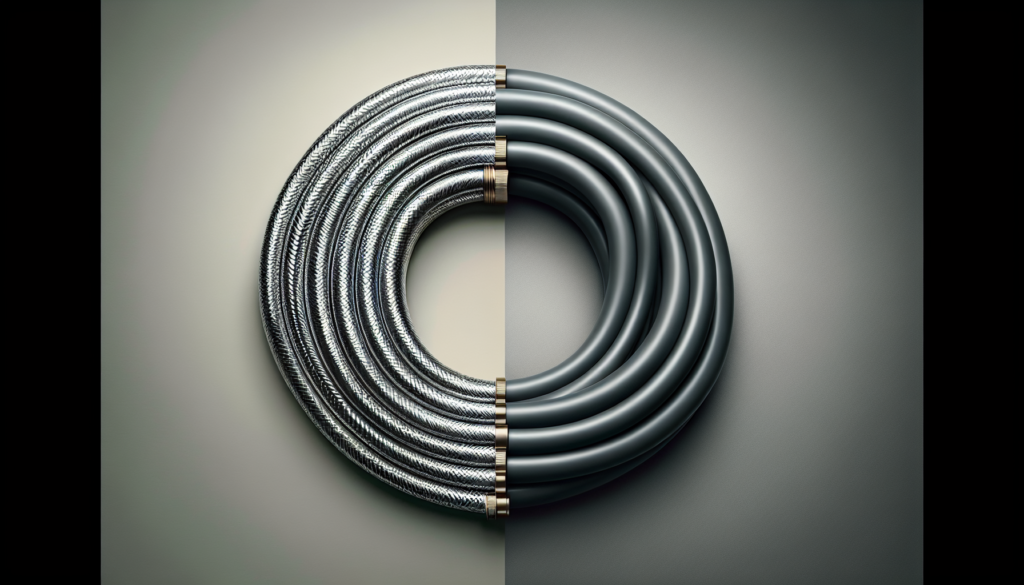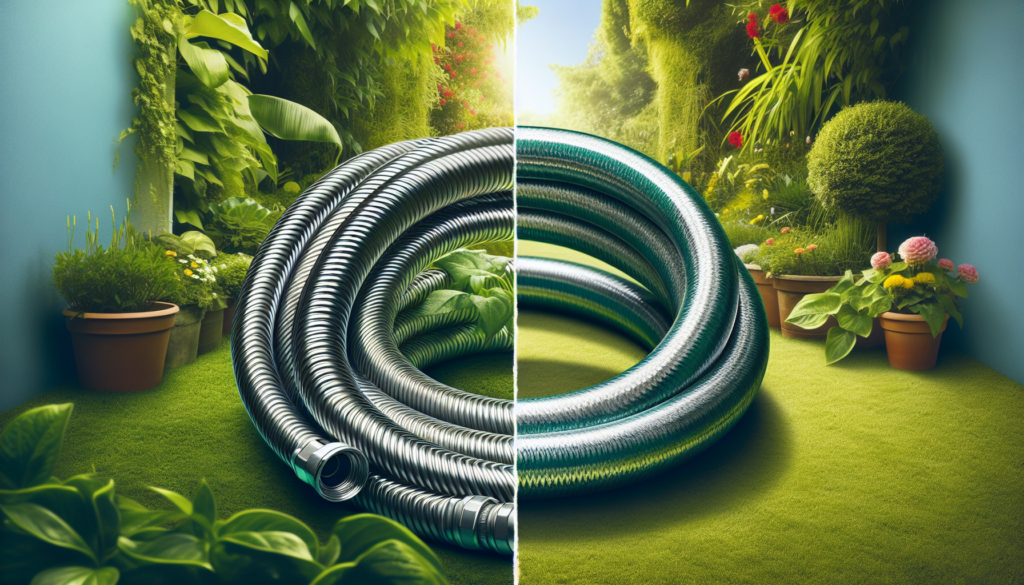Picture this: you’re in your garden, ready to water your plants and give them the love and care they deserve. But wait, you need a garden hose! Now, you’re faced with the age-old dilemma: stainless steel or rubber? Which one is truly the best? In this article, we’ll examine the pros and cons of both options, so you can make an informed decision and find the perfect garden hose for your needs. No need to fret anymore, because we’ve got you covered!
Durability
Stainless Steel Garden Hose
Stainless steel garden hoses are known for their exceptional durability. They are designed to withstand harsh weather conditions, including extreme temperatures and exposure to the sun. The stainless steel construction provides excellent resistance to rust and corrosion, making it a long-lasting option for outdoor use. These hoses are also highly resistant to punctures, ensuring that they can withstand accidental impacts without springing leaks.
Rubber Garden Hose
Rubber garden hoses are also known for their durability. Made from high-quality rubber materials, these hoses are designed to withstand regular use and abuse. They can endure constant pulling, dragging, and twisting without suffering any damage. Rubber hoses are also resistant to punctures, ensuring that they can withstand sharp objects or accidental impacts. With proper care and maintenance, a rubber garden hose can last for many years.
Flexibility
Stainless Steel Garden Hose
While stainless steel garden hoses are incredibly durable, they may lack the flexibility that rubber hoses offer. Due to their sturdy construction, stainless steel hoses are less pliable and may be harder to maneuver around tight corners or obstacles in your garden. However, they can still bend to some extent, allowing you to water your plants efficiently.
Rubber Garden Hose
Rubber garden hoses are highly flexible and offer excellent maneuverability. They can easily bend around corners, plants, and other obstacles without kinking. Rubber hoses are ideal for navigating through intricate garden landscapes, making it easier for you to water plants in hard-to-reach areas. The flexibility of rubber hoses also makes them easier to coil and store after use.
Resistance to Tangles
Stainless Steel Garden Hose
Stainless steel garden hoses are resistant to tangling, making them a convenient option for hassle-free watering. The stainless steel construction allows the hose to maintain its shape without twisting or tangling. This feature ensures a smooth water flow without any interruptions or time-consuming detangling.

Rubber Garden Hose
Rubber garden hoses are also designed to resist tangling. The flexibility and elasticity of rubber prevent the hose from coiling or looping on itself, eliminating the frustration of untangling knots. With a rubber hose, you can enjoy continuous watering without the hassle of dealing with tangles.
Resistance to Kinks
Stainless Steel Garden Hose
Stainless steel garden hoses are virtually kink-free. The sturdy construction and stainless steel material allow the hose to maintain its shape, even under pressure. This means that you won’t have to worry about frustrating kinks interrupting your watering routine. Stainless steel hoses provide a smooth and uninterrupted water flow, ensuring efficient irrigation.
Rubber Garden Hose
Rubber garden hoses are also known for their resistance to kinks. The flexibility and elasticity of rubber prevent the hose from forming permanent bends or kinks, ensuring a steady water flow. This feature allows you to water your garden without any interruptions caused by twisted or bent hoses.
Resistance to UV Damage
Stainless Steel Garden Hose
Stainless steel garden hoses are highly resistant to UV damage. The stainless steel material does not degrade when exposed to the sun’s harmful ultraviolet rays. Unlike other hoses that may become brittle or crack over time due to sun exposure, stainless steel hoses can withstand continuous sunlight without losing their durability or functionality.
Rubber Garden Hose
Rubber garden hoses also offer good resistance to UV damage. Most rubber hoses are constructed with UV-resistant materials that can withstand prolonged exposure to the sun. However, it is essential to note that rubber hoses may still deteriorate over time if consistently left in direct sunlight. Proper storage and occasional shade can help prolong the lifespan of your rubber garden hose.
Weight

Stainless Steel Garden Hose
Stainless steel garden hoses tend to be heavier compared to their rubber counterparts. The stainless steel construction adds weight to the hose, making it less lightweight and easy to carry around the garden. While the added weight may not be a significant concern for some users, it can be a consideration if you prefer a lightweight and portable hose.
Rubber Garden Hose
Rubber garden hoses are generally lighter in weight compared to stainless steel hoses. The lightweight nature of rubber hoses makes them easy to maneuver and carry, especially when you need to transport them around your garden. If you prioritize a lightweight hose that is effortless to handle, a rubber garden hose may be the better option for you.
Ease of Use
Stainless Steel Garden Hose
Stainless steel garden hoses are relatively easy to use. They often come with standard connectors that can be easily attached to faucets, nozzles, or sprinklers. The sturdiness of stainless steel hoses ensures that they won’t twist or kink during use, providing a seamless watering experience. Some stainless steel hoses also feature convenient features such as adjustable spray patterns or built-in shut-off valves for added convenience.
Rubber Garden Hose
Rubber garden hoses are also user-friendly. They typically come with connectors that can be easily attached to various watering tools. The flexibility and maneuverability of rubber hoses make them easy to handle and position, allowing for precise watering. Additionally, rubber hoses often provide a comfortable grip, ensuring that you can easily control the water flow without straining your hands.
Temperature Resistance
Stainless Steel Garden Hose
Stainless steel garden hoses exhibit excellent temperature resistance. They can withstand extreme hot and cold temperatures without sustaining damage or compromising their functionality. This feature makes stainless steel hoses suitable for year-round use, even in areas with fluctuating weather conditions.
Rubber Garden Hose
Rubber garden hoses also offer good temperature resistance. They can withstand both hot and cold water without losing their integrity. Rubber hoses are designed to handle temperature variations, ensuring that they won’t crack or deteriorate when exposed to extreme heat or cold. This feature makes rubber hoses suitable for use in various climates.
Price Range
Stainless Steel Garden Hose
Stainless steel garden hoses generally fall on the higher end of the price spectrum. The use of durable stainless steel materials and the added benefits of rust and corrosion resistance contribute to the higher price point. However, considering their exceptional durability and longevity, stainless steel hoses can be a worthwhile long-term investment for garden enthusiasts looking for a reliable hose option.
Rubber Garden Hose
Rubber garden hoses are typically more affordable compared to stainless steel hoses. The use of rubber materials allows for cost-effective production, making rubber hoses a budget-friendly choice for many gardeners. While they may not offer the same level of durability as stainless steel hoses, rubber hoses can still provide reliable performance at a more accessible price point.
Maintenance
Stainless Steel Garden Hose
Stainless steel garden hoses require minimal maintenance. Due to their resistance to rust and corrosion, they do not need regular cleaning or drying after each use. However, it is still recommended to inspect the hose periodically for any signs of damage or wear. If necessary, you can use a soft cloth or sponge to remove dirt or debris from the surface. Proper storage in a dry area can help maintain the hose’s longevity.
Rubber Garden Hose
Rubber garden hoses also require minimal maintenance. They can be easily cleaned by rinsing them with water after each use. It is important to remove any dirt or debris from the hose to prevent clogging or damage. Rubber hoses should be stored in a dry area to prevent mold or mildew growth. Regular inspection for cracks or leaks is also recommended to ensure the hose’s continued functionality.
In conclusion, both stainless steel and rubber garden hoses have their unique advantages. Stainless steel hoses offer exceptional durability, resistance to tangles and kinks, UV damage protection, and temperature resistance. They require minimal maintenance and can be a long-lasting investment. On the other hand, rubber hoses excel in flexibility, lightweight design, ease of use, and affordability. They also offer good resistance to tangles, kinks, UV damage, and temperature variations. Ultimately, the choice between the two depends on your specific needs, preferences, and budget. Whether you prioritize durability or flexibility, there is a garden hose option out there to suit your gardening requirements.
